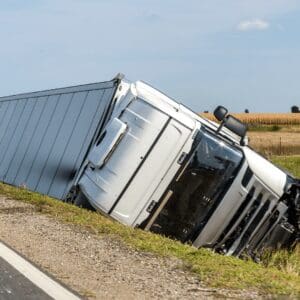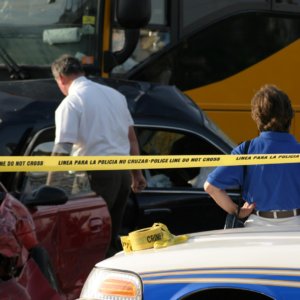What Percentage of Work Zone Related Accidents Involve Large Trucks?
When you drive by a work zone on a main road or highway, you’ll likely see several large trucks on your route: dump trucks, garbage 
We’re going to talk about the statistics on large trucks, work zone accidents, fatal crashes, how to avoid an accident, and what to do if you’ve been in an accident with a large commercial truck in a work zone.
If you have more questions, the Munley Law truck accident lawyers are standing by. We offer a free consultation where we will discuss your story, offer expert legal advice, and begin working on your truck accident claim to recover maximum compensation for your damages.
Statistics on Work Zone Accidents
In one year alone, over 100,000 work zone car crashes occurred, resulting in over 40,000 injuries and almost 1,000 fatalities. Work zones are dangerous for the average driver because they produce unexpected hazards, reduce the driver’s visibility, increase traffic congestion, temporarily change the signage, and can quickly force passenger vehicle operators to slow down. However, work zone accident statistics are even worse when they involve large trucks.
Truck Crashes in Work Zones
According to the Federal Motor Carrier Safety Administration (FMCSA) almost 30% of all work zone accidents involve large trucks. Unfortunately, the number of fatal truck accidents in work zones is increasing. In the last five years, there have been over 1,000 fatalities and over 18,000 life-changing injuries.
Causes of Truck-Related Accidents in Work Zones
Speeding
While we all may roll our eyes at the speed limit signs, the truth is, they’re there for a reason. Speeding slows down a driver’s reaction time, making it extremely difficult to avoid hazards or sudden changes in the road (i.e. construction zones!). A large commercial truck can weigh up to 80,000 pounds when carrying cargo. Weighing that much, it could take the truck around 525 feet to come to a complete stop – that’s 35 car lengths! If the truck driver is speeding, it will take even longer to stop the vehicle.
Work zones create sudden speed changes. For example, on a highway that normally has a 65 mph speed limit, a work zone may reduce that limit to 55 mph. If the motor vehicle is speeding at 80 or 90 mph, but has to suddenly halt because of the slowing traffic, it can cause a serious accident involving road construction trucks or other passenger cars.
Distracted Driving
Distracted driving is one of the main causes of all motor vehicle accidents, whether passenger vehicles or large commercial trucks. Distracted driving is anything that takes the driver’s focus off the road. It can be texting, eating, or even speaking with another passenger.
Truck drivers, like many other drivers on the road, are prone to distracted driving. This is especially dangerous in work zones and construction sites on the highway.
Tailgating
When commercial motor vehicles or regular passenger cars follow too closely behind another vehicle, it doesn’t give any room to stop or maneuver if the leading motor vehicle brakes or swerves suddenly. Tailgating is one of the most common causes of accidents and is especially dangerous in work zones where there are sudden lane closures and other hazards.
Truck Driver Fatigue
Truck drivers work long hours and are pressured to work for extended periods of time to speed up delivery times. This leads to severe fatigue and drowsy driving, which can cause a fatal accident. Drowsy driving impairs the truck driver’s judgment and reflexes. It even leads to drivers falling asleep at the wheel.
While the FMCSA implemented regulations and guidelines to ensure drivers do not drive while fatigued, truck drivers are still prone to drowsy driving.
Disregarding Warning Signs
Ignoring warning signs in work zones can lead to unexpected obstacles, sudden lane closures, or other hazards. Drivers must pay attention to warning signs and adjust their driving accordingly to avoid fatal and nonfatal crashes.
Impact of Large Truck Accidents in Work Zones
Large truck accidents in work zones are significant and can impact dozens of victims at once. A truck accident in a work zone can have devastating consequences for the individuals involved in the crash and the community at large. Here’s why:
Fatalities: Car passengers are significantly more likely to die than the truck driver if involved in a trucking accident. The sheer size and weight of the large truck makes the impact of the accident far more dangerous for the people in a passenger car.
- Injuries: If the passengers do survive a devastating collision, their injuries will be substantial and perhaps even life-altering. Victims of truck accidents (including the truck occupants) may sustain traumatic brain injuries, spinal cord injuries, burns, amputations, and broken bones.
- Property damage: Truck accidents can cause extensive damage to vehicles, construction equipment, and the community’s infrastructure. A truck accident involving multiple vehicles may cost millions of dollars in property damage.
- Traffic disruptions: Truck accidents cause major delays, congestion, and other traffic disruptions, which can actually lead to more car accidents!
- Psychological Trauma: Along with physical injuries, truck accident victims often experience emotional trauma as well. Victims dealing with injuries, especially injuries that completely change their way of life, can cause depression and loss of enjoyment of life.
What to Do if You’ve Been in a Truck Crash in a Construction Zone
- The first thing you need to do is call 911 to report the accident and seek medical attention. If the truck driver asks you not to call the police, do not listen. The responding officer will facilitate getting the proper medical personnel to the accident scene and will begin the initial accident report.
If your immediate medical needs have been addressed, start gathering as much information as possible. Take pictures and videos of your car and your injuries. Speak with any eye witnesses and take down their contact information. Record the truck driver’s name, license plate, insurance, and name of the trucking company.
- Next, you’ll have to report the truck accident to your insurance company. Provide them with the information you gathered. However, do not say anything that could be misconstrued as admission of fault. If an insurance adjuster tries to contact you, do not speak with him until you have a lawyer present.
- The next important step is hiring a Munley truck accident lawyer. Our experienced truck accident lawyers have won millions for our clients and are confident we can do the same for you. We have the expertise to handle complex truck accident cases and negotiate with powerful insurance companies on your behalf.
A Munley truck accident lawyer will be your legal guide throughout the claims process. Our legal team will handle:
- Filing your claim: Filing a personal injury claim against a truck driver, a trucking company, and construction companies can be complicated – a single misstep on the paperwork can cost you the entire case. Additionally, each state has time restrictions on filing personal injury claims. These restrictions are called the statute of limitations. Our lawyers will make sure the paperwork is filled out correctly and on time.
- Investigate your claim: The truck driver’s insurance company will investigate the accident and the crash scene. They will likely come to their own conclusion about what caused the accident, who caused the accident, and how much you deserve in a settlement. However, the Munley law firm will conduct our own independent investigation. We will hire accident reconstruction specialists, expert witnesses, and law enforcement experts to determine the liable parties and the cause of the accident.
- Negotiate with the insurance company: Going against a large trucking company and their powerful insurance company is intimidating, especially when you’re facing painful and life-altering injuries. A Munley Law truck accident lawyer will take over all negotiations with the insurance company. You can leave all correspondence to us – you will not have to speak to anyone throughout the case.
- If negotiations fail to reach a fair settlement, your truck accident attorney will take your case to court. The Munley personal injury lawyers are board-certified civil trial lawyers who will devise a legal strategy to secure a verdict in your favor.
- Finally, when you hire a Munley Law truck accident lawyer, you will give yourself time to recover. Follow your doctor’s instructions, and prioritize your physical and mental well-being. The Munley Law truck accident attorneys will handle the rest.
Work Zone Safety Tips (for Truck Drivers)
The following work zone safety tips apply to all drivers to help them avoid fatal truck crashes. Everyone should drive with extra caution when traveling through a construction site on the road or highway – for your safety and the safety of others.
However, because large commercial trucks are particularly dangerous to passenger vehicles on the road, there are a few guidelines for commercial drivers to follow for extra caution:
- Research your route: A lot of motor vehicle accidents happen on unknown roads and highways. Be sure to research your route so you are familiar with the roads. If you plan ahead, you may even be able to avoid driving through work zones.
- Pay attention: Every driver should be totally focused on the road. There are simply no excuses for dangerous distractions. Avoid using your cellphone, eating, drinking, tinkering with the radio, staring at the GPS, or even engaging in distracting conversation with your passengers.
- Slow down: Traffic patterns change and speeds can drastically reduce in work zones. Slow down when you enter a work zone and keep your eyes peeled for traffic signs and construction workers.
- Move over: Move into an open lane as soon as you can. Be sure to pay attention to your blind spot before shifting lanes.
- Create Space: Maintain at least four car lengths behind the vehicle in front of you. If you maintain extra space, you will be able to slow down in time if there are sudden stop in a work zone.

Marion Munley
Marion Munley is recognized for her compassionate representation of catastrophically injured clients and her steadfast dedication to them and their families. Her advocacy has produced numerous multimillion-dollar recoveries, including one of the largest trucking accident settlements on record. Marion is Triple Board Certified by the National Board of Trial Advocacy in Civil Trial, Civil Practice, and Truck Law, and since 2023 has been named one of Pennsylvania’s Top 10 Super Lawyers by Super Lawyers.

 Fatalities: Car passengers are significantly more likely to die than the truck driver if involved in a trucking accident. The sheer size and weight of the large truck makes the impact of the accident far
Fatalities: Car passengers are significantly more likely to die than the truck driver if involved in a trucking accident. The sheer size and weight of the large truck makes the impact of the accident far  If your immediate medical needs have been addressed, start gathering as much information as possible. Take pictures and videos of your car and your injuries. Speak with any eye witnesses and take down their contact information. Record the truck driver’s name, license plate, insurance, and name of the trucking company.
If your immediate medical needs have been addressed, start gathering as much information as possible. Take pictures and videos of your car and your injuries. Speak with any eye witnesses and take down their contact information. Record the truck driver’s name, license plate, insurance, and name of the trucking company.







